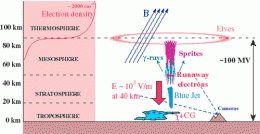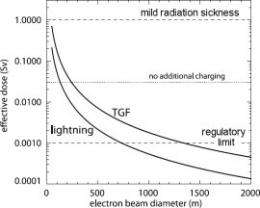Are TGFs Hazardous to Air Travelers?

Instruments scanning outer space for cataclysmic explosions called gamma-ray bursts are detecting intense flashes of gamma-ray energy right here in the friendly skies of Earth. These terrestrial gamma-ray flashes, or TGFs, blast through thunderstorms close to the altitude where commercial airliners fly. In fact, they could be too close for comfort.
In a recent study,* scientists estimated that airline passengers could be exposed to 400 chest X-rays worth of radiation by being near the origin of a single millisecond blast. Joe Dwyer of the Florida Institute of Technology took part in that research, which used observations from NASA's Reuven Ramaty High Energy Solar Spectroscopic Imager, or RHESSI, to estimate the danger TGFs pose.
"We believe the risk of encountering a TGF in an airplane is very small," says Dwyer. "I wouldn't hesitate to take a flight. Pilots already avoid thunderstorms because of turbulence, hail, and lightning, and we may just have to add TGFs to the list of reasons to steer clear of those storms."
But, he stresses, "it's worth looking into."
NASA's Gamma-ray Burst Monitor (GBM) on the Fermi Gamma-ray Telescope will help evaluate the hazards.
"GBM provides the best TGF data we have so far," says Dwyer. "It gets better measurements of their spectra than any previous instrument, giving us a more accurate idea of just how energetic they are."
Although TGFs are quite brief (1-2 milliseconds), they appear to be the most energetic events on Earth. They belch destructive gamma-rays packing over ten million times the energy of visible light photons - enough punch to penetrate several inches of lead.
"It's amazing," says Jerry Fishman, a co-investigator for the Gamma-ray Burst Monitor. "They come blasting right through the whole Fermi spacecraft and light up all of our detectors. Very few cosmic gamma-ray bursts manage to do this!"

The origin of TGFs is still a mystery, but researchers know this much: TGFs are associated with thunderstorms and lightning. "We think the electric field in a thunderstorm may get so strong that the storm itself turns into a gamma-ray factory," says Dwyer. "But we don't know exactly how or why or where inside the storm this happens."
So no one yet knows how often, if ever, planes end up in the wrong place at the wrong time.
It's possible that lightning bolts trigger TGFs. Or maybe TGFs trigger lightning bolts. Researchers aren't sure which comes first. GBM's excellent timing accuracy - to within 2 microseconds - will help solve this riddle.
"For some of the TGFs, we've pinpointed the associated lightning," says Dwyer. "This information along with the spectrum should help us figure out how deep in the atmosphere a TGF source is and how many gamma-rays it's emitting. Then we can determine the altitude and location they're coming from in the thunderstorm."
Fishman offers some good news: "If TGFs originate near the tops of thunderstorms and propagate upward from there, airline passengers would be safe."
By looking closely at a TGF's life cycle, that is, how quickly it turns on and off, GBM may also help researchers calculate how large and concentrated the gamma-ray source is. If the gamma-rays are emitted over a large region, the radiation dose would be diluted and much less harmful.

"But if the source is compact and the gamma-rays originate close to an aircraft, then that could be a problem," says Fishman.
"Of course the smaller the source the lower the odds of a plane ending up close to it," adds Dwyer.
GBM wasn't designed to look for TGFs, but GBM co-investigator Michael Briggs has greatly enhanced its sensitivity to them by writing new software.
"TGFs have really been an afterthought for missions so far," says Dwyer. RHESSI, for example, points at the sun, but the RHESSI team figured out a way to measure TGFs by detecting gamma-rays coming in through the satellite's backside. "All these instruments have been pointing across the universe, while right over our heads these monsters are going off!"
"Now the whole field of TGFs is on fire," says Fishman. "People are jumping on the bandwagon to try to figure them out."
More information: *Journal of Geophysical Research (Atmospheres), "Estimation of the fluence of high-energy electron bursts produced by thunderclouds and the resulting radiation doses received in aircraft" by J. Dwyer et al. (in press).
Source: Science@NASA, by Dauna Coulter
















